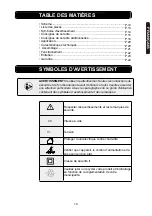
ENGLIS
H
aDDITIONaL SaFETY WaRNINGS
•
Hold power tools by insulated gripping surfaces when performing
an operation where the cutting tool may contact hidden wiring or its
own cord. Contact with a ″live″ wire will make exposed metal parts
of the tool ″live″ and shock the operator.
•
Use clamps or other practical way to secure and support the
workpiece to a stable platform. Holding the work by hand or against
your body is unstable and may lead to loss of control.
•
Do not drill, fasten or break into existing walls or other blind areas
where electrical wiring may exist. If this situation is unavoidable,
disconnect all fuses or circuit breakers feeding this worksite.
•
Always wear safety goggles or eye protection when using this tool.
Use a dust mask or respirator for applications that generate dust.
•
Use thick cushioned gloves and limit the exposure time by taking
frequent rest periods. Vibration caused by hammer-drill action may
be harmful to your hands and arms.
•
Secure the material being drilled. Never hold it in your hand
or across legs. Unstable support can cause the drill bit to bind
causing loss of control and injury.
•
Never leave the trigger locked "ON". Before plugging the tool in,
check that the trigger lock is "OFF". Accidental start-ups could
cause injury.
•
Position the cord clear of rotating bit. Do not wrap the cord around
your arm or wrist. If you lose control and have the cord wrapped
around your arm or wrist it may entrap you and cause injury.
•
Position yourself to avoid being caught between the tool or side
handle and walls or posts. Should the bit become bound or
jammed in the work, the reaction torque of the tool could crush
your hand or leg.
•
If the bit becomes bound in the workpiece, release the trigger
immediately, reverse the direction of rotation and slowly squeeze
the trigger to back out the bit. Be ready for a strong reaction torque.
The drill body will tend to twist in the opposite direction as the drill
bit is rotating.
•
Do not grasp the tool or place your hands too close to the spinning
chuck or drill bit. Your hand may be lacerated.
•
Do not use the switch "lock-on" feature in situations where drill bit
binding is likely. (For example: just before the bit is ready to break
through the material, anytime when using a "Hole Saw", auger
bits........ etc.) When the bit binds, the drill's body will twist or kick-
back in opposite direction and the release of the trigger "lock-on"
may be difficult.
•
Be aware of the location and setting of the switch "lock-on" button.
If the switch is locked "ON" during the use, be ready for emergency
situations to switch it "OFF", by first pulling the trigger then
immediately releasing it without pressing the "lock-on" button.
•
When installing a drill bit, insert the shank of the bit well within
the jaws of the chuck. If the bit is not inserted deep enough, the
5







































